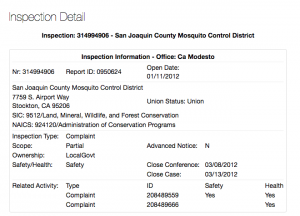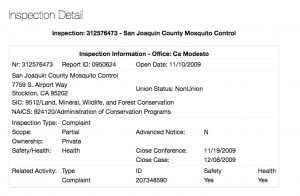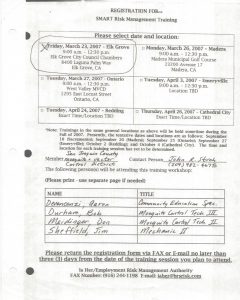Department of Labor Standards OSHA
Employer Responsibilities
Under the OSH law, employers have a responsibility to provide a safe workplace. This is a short summary of key employer responsibilities:
- Provide a workplace free from serious recognized hazards and comply with standards, rules and regulations issued under the OSH Act.
- Examine workplace conditions to make sure they conform to applicable OSHA standards.
- Make sure employees have and use safe tools and equipment and properly maintain this equipment.
- Use color codes, posters, labels or signs to warn employees of potential hazards.
- Establish or update operating procedures and communicate them so that employees follow safety and health requirements.
- Employers must provide safety training in a language and vocabulary workers can understand.
- Employers with hazardous chemicals in the workplace must develop and implement a written hazard communication program and train employees on the hazards they are exposed to and proper precautions (and a copy of safety data sheets must be readily available). See the OSHA page on Hazard Communication.
- Provide medical examinations and training when required by OSHA standards.
- Post, at a prominent location within the workplace, the OSHA poster (or the state-plan equivalent) informing employees of their rights and responsibilities.
- Report to the nearest OSHA office all work-related fatalities within 8 hours, and all work-related inpatient hospitalizations, all amputations and all losses of an eye within 24 hours. Call our toll-free number: 1-800-321-OSHA (6742); TTY 1-877-889-5627. [Employers under federal OSHA’s jurisdiction were required to begin reporting by Jan. 1, 2015. Establishments in a state with a state-run OSHA program should contact their state plan for the implementation date].
- Keep records of work-related injuries and illnesses. (Note: Employers with 10 or fewer employees and employers in certain low-hazard industries are exempt from this requirement.
- Provide employees, former employees and their representatives access to the Log of Work-Related Injuries and Illnesses (OSHA Form 300). On February 1, and for three months, covered employers must post the summary of the OSHA log of injuries and illnesses (OSHA Form 300A).
- Provide access to employee medical records and exposure records to employees or their authorized representatives.
- Provide to the OSHA compliance officer the names of authorized employee representatives who may be asked to accompany the compliance officer during an inspection.
- Not discriminate against employees who exercise their rights under the Act. See our “Whistleblower Protection” webpage.
- Post OSHA citations at or near the work area involved. Each citation must remain posted until the violation has been corrected, or for three working days, whichever is longer. Post abatement verification documents or tags.
- Correct cited violations by the deadline set in the OSHA citation and submit required abatement verification documentation.
- OSHA encourages all employers to adopt an Injury and Illness Prevention Program. Injury and Illness Prevention Programs, known by a variety of names, are universal interventions that can substantially reduce the number and severity of workplace injuries and alleviate the associated financial burdens on U.S. workplaces. Many states have requirements or voluntary guidelines for workplace Injury and Illness Prevention Programs. Also, numerous employers in the United States already manage safety using Injury and Illness Prevention Programs, and we believe that all employers can and should do the same. Most successful Injury and Illness Prevention Programs are based on a common set of key elements. These include: management leadership, worker participation, hazard identification, hazard prevention and control, education and training, and program evaluation and improvement. OSHA’s Injury and Illness Prevention Programs topics page contains more information including examples of programs and systems that have reduced workplace injuries and illnesses.
- For more information, refer to the following online publications and resources.
All About OSHA*
OSHA Inspections*
Top Ten OSHA Standards Cited - For more information, see OSHA’s enforcement page
Regulations (Standards – 29 CFR)
| Regulations (Standards – 29 CFR) – Table of Contents
|
| • Part Number: | 1904 |
| • Part Title: | Recording and Reporting Occupational Injuries and Illness |
| • Subpart: | C |
| • Subpart Title: | Recordkeeping Forms and Recording Criteria |
| • Standard Number: | 1904.7 |
| • Title: | General recording criteria. |
| • GPO Source: | e-CFR |
Basic requirement. You must consider an injury or illness to meet the general recording criteria, and therefore to be recordable, if it results in any of the following: death, days away from work, restricted work or transfer to another job, medical treatment beyond first aid, or loss of consciousness. You must also consider a case to meet the general recording criteria if it involves a significant injury or illness diagnosed by a physician or other licensed health care professional, even if it does not result in death, days away from work, restricted work or job transfer, medical treatment beyond first aid, or loss of consciousness.
| Regulations (Standards – 29 CFR) – Table of Contents
|
| • Part Number: | 1904 |
| • Part Title: | Recording and Reporting Occupational Injuries and Illness |
| • Subpart: | C |
| • Subpart Title: | Recordkeeping Forms and Recording Criteria |
| • Standard Number: | 1904.7 |
| • Title: | General recording criteria. |
| • GPO Source: | e-CFR |
Basic requirement. You must consider an injury or illness to meet the general recording criteria, and therefore to be recordable, if it results in any of the following: death, days away from work, restricted work or transfer to another job, medical treatment beyond first aid, or loss of consciousness. You must also consider a case to meet the general recording criteria if it involves a significant injury or illness diagnosed by a physician or other licensed health care professional, even if it does not result in death, days away from work, restricted work or job transfer, medical treatment beyond first aid, or loss of consciousness.
| Regulations (Standards – 29 CFR) – Table of Contents
|
| • Part Number: | 1910 |
| • Part Title: | Occupational Safety and Health Standards |
| • Subpart: | A |
| • Subpart Title: | General |
| • Standard Number: | 1910.9 |
| • Title: | Compliance duties owed to each employee. |
| • GPO Source: | e-CFR |
Personal protective equipment. Standards in this part requiring the employer to provide personal protective equipment (PPE), including respirators and other types of PPE, because of hazards to employees impose a separate compliance duty with respect to each employee covered by the requirement. The employer must provide PPE to each employee required to use the PPE, and each failure to provide PPE to an employee may be considered a separate violation.
Training. Standards in this part requiring training on hazards and related matters, such as standards requiring that employees receive training or that the employer train employees, provide training to employees, or institute or implement a training program, impose a separate compliance duty with respect to each employee covered by the requirement. The employer must train each affected employee in the manner required by the standard, and each failure to train an employee may be considered a separate violation.
[FR 73 75583, Dec. 12, 2008]
OSHA ACCESS To Medical Exposure Records

April 4, 2016 Sig Wynne-Evans Department of Industrial Relations Cal/OSHA
Items 2. Incomplete Medical File Missing Doctors First Report, OSHA Notification, Fraud Information by Employer. After a intermittent week of spraying fish ponds, testing water at the fish hatchery.
Item 3 . Dr Manual Orellana Internal Medicine was their physician. Blatant lie to OSHA. Paid Cash for lower insurance claims reported.
Items 6. Training Records OSHA Violation To Date
Item 7. Provide training where required by special OSHA standards, such as Hazard Communication, Lockout/Tagout, Con ned Space, or Bloodborne Pathogens. Appendix B: Relationship of Guidelines to Existing OSHA Standards lists examples of commonly applicable OSHA standards that require training.
- Evidence Spraying Ponds on Timesheet January 20, 2005 at White Slough. Please provide my license, training records, medical treatment and monitoring exposure documents
2. Evidence of Medical Treatment by employers Infectious disease specialist Manual Orellana, M.D.
06-04-14 OSHA DOL Inspection Detail Trenton NJ
Complaint 1/13/14
Complaint 01/11/12
07-27-10 Tiffany Retaliation for Subpoena In Meidinger WCAB Case – For 8:26:2010
Complaint 11/10/09
They did not report Duane Bridgewater’s death
Died January 14, 2009 age 59
Employer Neglected to inform employees of
toxic exposure treatments at white slough
Janine has been out on 3 work injuries. All her claims were paid with her salary and she did not have to use the work-comp Delay, Deny and Double Standards. Janine was a key witness testifying against Meidinger. I was a key witness for Meidinger.
07-28-10 Bob & Janine Meidinger Heart attack 2006- 2010 Stockwell Harris & Vector Control
Exposure 1 Date of Injury June 7, 2004
6-07-04 OSHA Employer’s Report Form 5020























